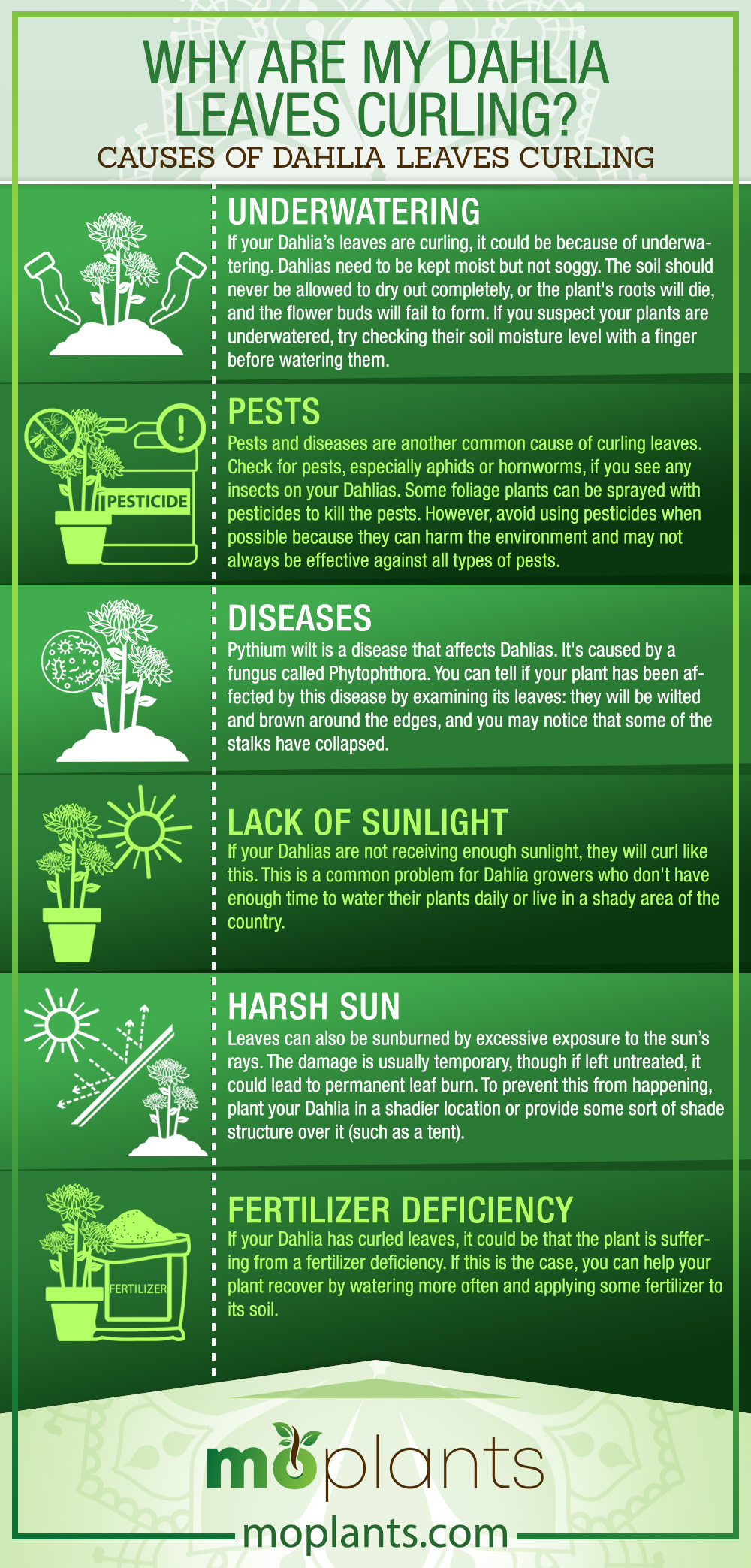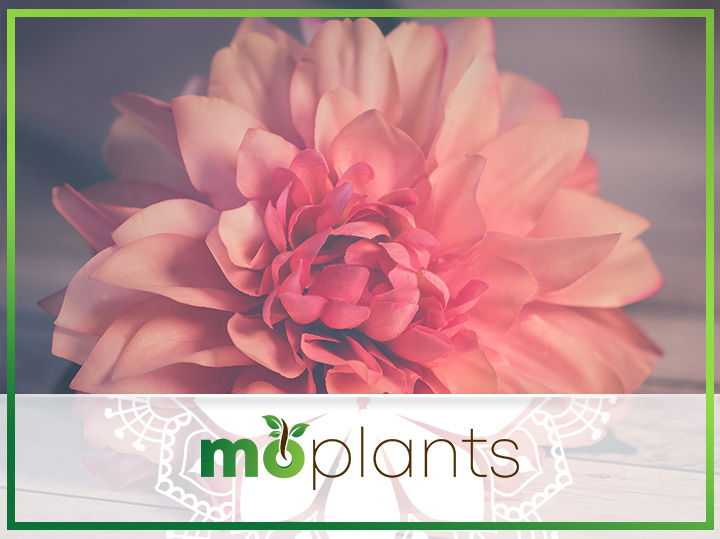Dahlias are one of the most popular flowering plants for home gardens. They come in all kinds of colors, heights, and shapes. They also have a unique characteristic: when their leaves curl up, they look like little hands waving to you! This can be a beautiful sight and an excellent conversation starter, but sometimes it can also be frustrating if your Dahlia’s leaves have been curling for no apparent reason. In this article, we will discuss why Dahlias leaves curl and how to prevent them from doing so.
Causes of Dahlia Leaves Curling
- Underwatering: If your Dahlia is not getting enough water, its leaves will curl and wither.
- Pests: Aphids, scale insects, and other pests can damage your plant if it hasn’t been appropriately treated for them.
- Diseases: A variety of diseases can cause your plants to curl their leaves. This includes viruses, bacteria, and fungi in the soil or the plant itself.
- Lack of sunlight: If you are growing Dahlias in a shady area or indoors under artificial lighting (a common mistake), they will not get enough light to grow properly, which may result in curling leaves as a symptom of this issue.
- Harsh sun exposure: Too much direct sunlight can cause wilting or scorching Dahlia foliage. Still, too little light causes poor growth with no energy production needed by cells within each leaf surface area, which leads to early death due to starvation. This causes premature leaf loss while still attached at the stem base location where no buds were left behind from previous years’ growth cycle when it was more plentiful due to having lots more shoots around. Today’s climate conditions are much drier than before, which means less humidity overall.
Underwatering
If your Dahlia’s leaves are curling, it could be because of underwatering. Dahlias need to be kept moist but not soggy. The soil should never be allowed to dry out completely, or the plant’s roots will die, and the flower buds will fail to form. If you suspect your plants are underwatered, try checking their soil moisture level with a finger before watering them. If it feels dry down at least 1 inch (2 cm), it’s time for a drink!
The best way to ensure that your Dahlia is getting enough water is by using either an automatic drip system or, even better: setting up a rain barrel. With these methods, you can ensure that every drop gets where it needs to go without any water wastage.
Pests
Pests and diseases are another common cause of curling leaves. Check for pests, especially aphids or hornworms, if you see any insects on your Dahlias. Some foliage plants can be sprayed with pesticides to kill the pests. However, avoid using pesticides when possible because they can harm the environment and may not always be effective against all types of pests.
Use organic pesticides instead of traditional ones like insecticides or fungicides if you want to minimize environmental impact.
You should also check for diseases that infect Dahlia plants—these typically cause yellowing leaves and leaf spotting (the appearance of small dots), making the plant look sickly even before it dies off completely! If you notice these symptoms in your plant(s), try pruning off affected leaves and stems so as not to spread disease further through its root system.
Diseases
Pythium wilt is a disease that affects Dahlias. It’s caused by a fungus called Phytophthora. You can tell if your plant has been affected by this disease by examining its leaves: they will be wilted and brown around the edges, and you may notice that some of the stalks have collapsed. If your Dahlia shows signs of pythium wilt, remove it from your garden immediately to prevent further infections.
The best way to avoid diseases on your Dahlias is to keep them well-drained—they need good drainage because they’re shallow-rooted plants that compete with weeds for nutrients in the soil (this also makes them easy targets for pythium). Watering at night also helps keep fungal spores from getting into the leaves; however, overwatering will cause roots to rot and spread diseases through root rot as well as via water splashing onto leaves during heavy rainfall or irrigation cycles (which can happen quickly in California!).
It’s important to remove not only diseased plants but also any debris or leftover plant parts—you should dispose of these things either by burning them outdoors or composting them away from where healthy plants are growing, so they don’t infect those areas too.
Lack of Sunlight
If your Dahlias are not receiving enough sunlight, they will curl like this. This is a common problem for Dahlia growers who don’t have enough time to water their plants daily or live in a shady area of the country. If you’re growing your Dahlias indoors and have them located near a window that isn’t directly facing the sun, move their location so that they get the direct sunlight they need for maximum growth.
If this doesn’t work, try using artificial lighting (aka grow lights) to supplement the hours of daylight your Dahlias are not getting outside. Grow lights mimic natural light by emitting wavelengths that tell plants when it’s time to produce flowers and fruit. You can purchase them at any hardware or gardening store; just make sure whatever type you choose has an adjustable height so as not to burn any leaves while still giving off enough energy for blooms.
Harsh Sun
Leaves can also be sunburned by excessive exposure to the sun’s rays. The damage is usually temporary, though if left untreated, it could lead to permanent leaf burn.
To prevent this from happening, plant your Dahlia in a shadier location or provide some sort of shade structure over it (such as a tent). If you do end up with leaves that look burned, you can treat them by applying a cold compress directly onto each discolored leaf petal until they return to normal coloration.
Fertilizer Deficiency
If your Dahlia has curled leaves, it could be that the plant is suffering from a fertilizer deficiency. If this is the case, you can help your plant recover by watering more often and applying some fertilizer to its soil.
You may also notice that a Dahlia that’s suffering from a fertilizer deficiency is stunted or yellow in color—two other symptoms of this problem.
If you want to know for sure whether or not you’re dealing with a fertilization issue, try looking at the bottom of your flower’s leaves: if they’re browning outwards towards their edges (like what we see here), then it’s likely due to too little nutrients being provided by its caretakers rather than anything else.
Infographic

Solutions for Dahlia Leaves Curling
- Check the soil. Your Dahlia’s soil may be too dry, or it may need to be amended with compost or fertilizer.
- Check the temperature. Make sure that your Dahlias are not exposed to excessive heat for extended periods of time (especially if they’re in pots), as this can cause scorching and sunburned leaves. If you live in a temperate climate and want to plant your Dahlias outside, choose a spot where they will receive partial shade from an overhang or tree canopy throughout most of the day; this will help prevent wilting, and leaf curl as well as encourage more blooms!
- Fertilize regularly but don’t overdo it—too much fertilizer can lead to leaf problems such as scorching or yellowing due to nitrogen toxicity (signs include brown patches on leaves). You should also avoid mulch near your Dahlia plants because it can harbor pests like slugs or snails. These can nibble holes into developing buds as they grow up through thin stems, but placing protective covers made from plastic bottles around each stem before planting helps ensure that no animals have access when it comes time for seeds/buds/flowers etc.
- Water your plants regularly so that they don’t dry out too much between watering sessions, but don’t overwater them either. Wet soil causes the plant’s root system to rot, which will cause the leaves to curl up at their edges due to a lack of oxygen supply to those areas of the plant where this occurs (usually near its base).
- Apply mulch or compost to the beds of the Dahlias so that their root systems are not under stress from being too hot and dry.
- Scare away any winter moths which lay their eggs in the plant stems.
- Avoid pruning your plants in the middle of summer because this can cause the roots to dry out and put stress on the plant, which will potentially result in leggy growth.
- If your plant is growing properly but still wilting, there may be a problem with the soil or drainage in your pot. Try adding some perlite or sand to improve drainage and aeration around the roots.
Our Final Thoughts
If your Dahlias are curling, the best way to fix them is by increasing the amount of water they receive. You also need to ensure they have plenty of sunlight but not too much sun exposure, or they will burn. Finally, you should check for any pests or diseases that might be causing your plants to curl up like this so that you can take action immediately before it damages other parts of the plant.

